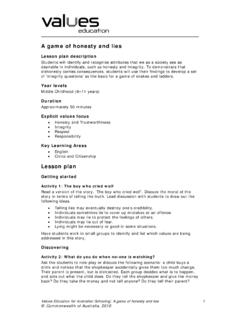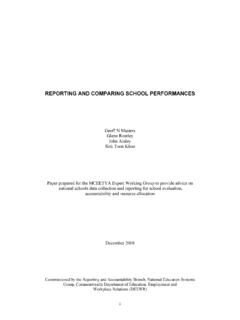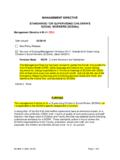Transcription of Staying on at school: Improving student retention in …
1 Staying on at school : Improving student retention in australia Report for the Queensland Department of Education and the Arts by Stephen Lamb, The University of Melbourne Anne Walstab, The University of Melbourne Richard Teese, The University of Melbourne Margaret Vickers, University of Western Sydney Russ Rumberger, University of california , Santa Barbara Centre for Post-compulsory Education and Lifelong Learning, The University of Melbourne August 2004. Centre for Post-compulsory Education and Lifelong Learning The University of Melbourne This report was commissioned by the Queensland Department of Education and the Arts on behalf of the National Fund for Educational Research. The views expressed in this report are solely those of the authors and are not necessarily those of the Ministerial Council on Education, Employment, Training and Youth Affairs or individual State/Territory or Australian Government Education Ministers or Departments responsible for education.
2 The State of Queensland (Department of Education and the Arts) 2004. Copyright protects this publication. Except for purposes permitted by the Copyright Act, reproduction by whatever means is prohibited without prior written permission from the publisher. Requests and inquiries concerning reproduction and rights should be addressed to the Copyright Officer, Department of Education and the Arts, PO Box 33, Brisbane Albert Street Q 4002. ii ACKNOWLEDGEMENTS. The authors gratefully acknowledge the generous assistance and support provided throughout the project by Chris Bain of the Queensland Department of Education and the Arts. The authors would also like to thank the members of the project Steering Committee for their generous contributions and input: Chris Bain, Garry Cislowski, Helen Eastburn, Jenny Haddrell, Kath Kayrooz, Lucio Krbavac, Carol Markie-Dadds, Bob Rasmussen, Col Sutcliffe and Helen Tunbridge.
3 The authors also express their appreciation to all of the senior education officers State, Territory and Federal who participated in the interviews and workshops that were conducted as part of the project, as well as to the staff and principals of the 24 schools in New South Wales, Queensland, South australia and Western australia who were interviewed as part of the review of factors influencing retention . iii CONTENTS. List of Tables and Figures vi Executive Summary viii Introduction .. 1. Context ..2. Aims of the report ..5. Structure of the report ..6. Part A: Review of National and International Literature on retention 1: Reasons for completion or early Educational plans and early leaving or completion ..10. Young people's reasons for completing or leaving school An emerging model of the factors driving early leaving.
4 17. 2: Demographic and individual Demographic factors ..19. The process of withdrawal from Conclusion ..31. 3: Regional and economic Labour market factors ..33. Regional context ..38. Conclusion ..41. 4: school policies and context ..42. Government and private Teacher quality: attributes and Curriculum and retention ..48. Conclusion ..53. 5: Interventions based on student needs ..55. Addressing financial barriers ..55. Prevention Recovery programs ..65. Conclusion ..69. iv Part B: school and System Interviews 6: System and school Staff Overarching issues: system Overarching issues: school staff reasons for early leaving ..73. System and school level responses ..76. Conclusion ..88. Part C: Modelling of Factors Affecting Year 12 retention 7: Draft models of school completion and early Factors shaping completion and early leaving.
5 91. Factors shaping state differences in completion and early 8: Modelling state and territory differences ..101. Modelling apparent retention in Cumulative impact of Conclusion ..124. 9: Modelling differences over time: 1981 Data and method ..125. Model of retention rates 1981 to 2002 ..126. Conclusion ..132. 10: Modelling differences between individuals ..133. Defining retention ..133. Applying the conceptual model of Conclusion ..144. Part D: Policy Considerations 11: Policy Considerations ..146. retention : the MCEETYA Guiding principles for From principles to Further Index 180. v TABLES AND FIGURES. Tables Table school plans, by outcome national sample of Year 9 Table Reasons for dropping out of school ..12. Table Main reason for leaving school before completing Year 12 (a), 1997.
6 13. Table Main reason given for early school leaving among YA Recipients ..16. Table Attainment rates, by SES australia , 1999 (%)..22. Table SES profiles of Year 9 students , by sector australia , 1995 ..43. Table Summary of selected empirical literature ..93. Table Empirical literature on state and territory differences ..97. Table Apparent retention rates for 2002 and adjustments ..123. Table Results from regression model predicting changes in retention ..127. Table Effects of different factors on student retention expressed as odds ratios ..136. Table Glossary of variables used in the model of student retention ..138. Figures Figure 1 Apparent retention rates (Year 7/8 to Year 12), australia 1967 Figure 2 Apparent retention rates, by state and territory: 1981 Figure A conceptual model of the reasons young people give for leaving school early17.
7 Figure Apparent retention rates, by gender australia , 1967-1998 (%) ..20. Figure Post Year 10 plans, by geographical region boys, QLD, Figure Apparent retention rates, by sector australia , Figure A conceptual model of completion and early Figure A conceptual model of state and territory differences in completion and early Figure Apparent retention rates, by state and territory Figure Adjustments required for differences in population change, by state and territory (%) ..107. Figure Adjustments required for differences in numbers of part-time students , by state and territory ..108. vi Figure Adjustments required for differences in numbers of mature-age students , by state and territory ..109. Figure Adjustments required for differences in numbers of cross-border students , by state and territory.
8 110. Figure Adjustments required for differences in SES composition of populations, by state and territory ..114. Figure Adjustments required for differences in population density and remoteness, by state and territory ..115. Figure Adjustments required for differences in size of the indigenous population, by state and territory ..116. Figure Adjustments required for differences in size of sector enrolment shares, by state and territory ..117. Figure Adjustments required for differences in secondary college provision, by state and Figure Adjustments required for VET as an alternative to school , by state and Figure Comparisons of predicted and published retention rates, by state and 128. Figure Structural equation model of educational attainment.
9 134. vii EXECUTIVE SUMMARY. This report was commissioned by the Queensland Department of Education and the Arts (QDEA) on behalf of the National Fund for Educational Research to identify the main drivers of current trends in retention rates across States and Territories, and to develop a set of models to predict differences in patterns of retention . The study involved four main components: 1. An extensive review of national and international literature on school completion and early leaving, in order to identify key factors affecting retention and participation. 2. A series of interviews with a sample of retention experts' including school staff and policymakers to identify, from their experience, the key factors that shape survival in school and study.
10 3. The development and application of a set of models of student retention to measure the impact of factors shaping student retention and differences across States and Territories. 4. An examination of policy implications and policy options based on the results of the study. The analysis was informed by a set of workshops held with senior education policy officers across four States. The literature review and consultations with school and system authorities identified sets of factors that shape student retention . The work suggested that patterns of student retention are based on a complex interplay between a range of factors including social and demographic ( gender, achievement, student aspirations and motivations, family SES, ethnicity, indigenous status, health and disability, homelessness), regional and economic ( urban, rural or remote, youth labour market, unemployment, part-time employment, industry structure, community links), school policies and context ( sector, school quality, teacher quality, pedagogical effectiveness, school resourcing, school organisation) and the policy environment ( system, state, and commonwealth policies, curriculum and qualification framework, income support).










